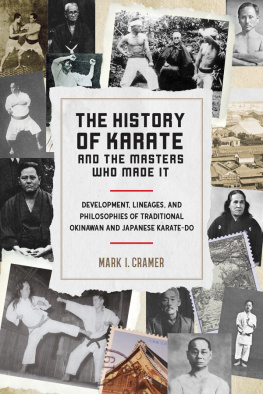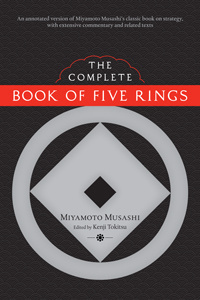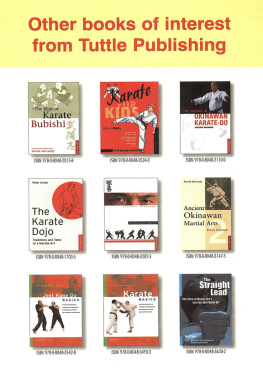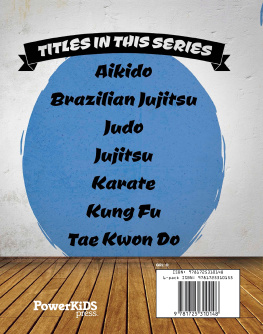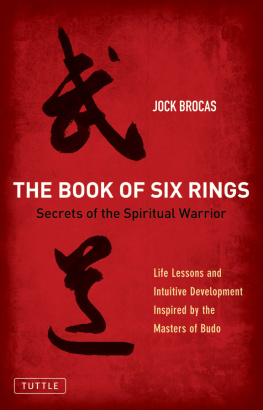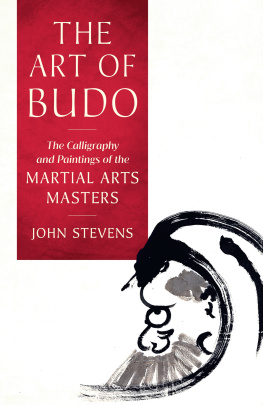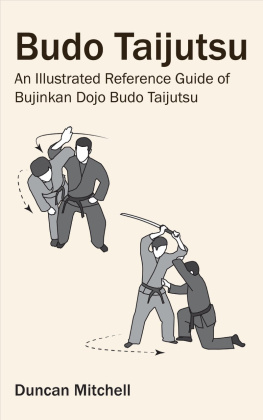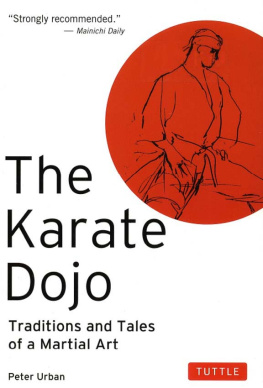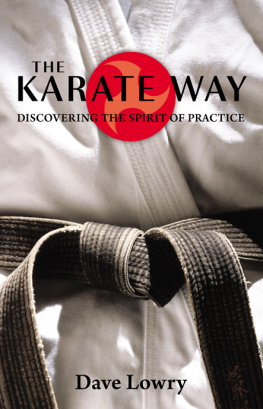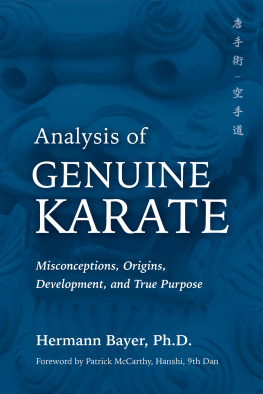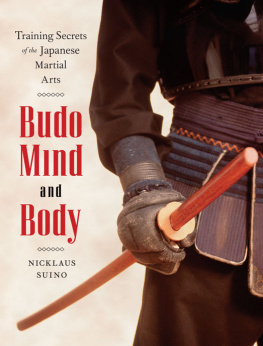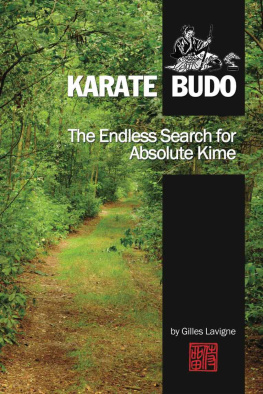Introduction
A Martial Art for Everyone
I was born in 1918. I have been happy to spend all my life with karate. My father, Mabuni Kenwa, who founded the Shit karate, always said: Anyone can practice karate, young and old people, men and women. Karate can meet different needs of different people. It can be used to take care of the health and to maintain beauty and fitness, and of course it can be a means of self-defense or of real fighting. But that is not all. In particular bud karate is not only a system of physical techniques, called taijutsu , but also rich in mental techniques, called shinjutsu . Once during a kata performance by an experienced karateka, I heard a bystander saying: Just by feeling this spiritual energy, I understand that karate is something of great value.
Other people like karate as a means of artistic expression. For example, at the Sydney Olympic Games in 2000 the Austrian team in synchronized swimming caused considerable public discussion because they included a karate kata called Heian yondan into their performance. In August 2001 in the Nihon Budkan the 3 rd Shit Karate World Meeting took place. I met a famous Japanese dancer there who told me: I can see a connection between karate and dance.
To my mind karate can be compared with a huge mountain that can be climbed via many different paths, which will reveal very different sights according to the point of view or to the season. Neither the aims nor the paths of this mountain hiking adventure are fixed. Some walk slowly up the hillside to build up their physical strength, others, the ambitious mountaineers, want to climb the highest and steepest summits at any cost.
Karate as a Means for Physical, Martial and Spiritual Education
Education and development in karate comprise three main elements: the physical, the martial and the psycho-spiritual aspect. As a means of physical education it improves the health and provides the basis for a long and healthy life. It helps to build up fighting abilities, and as a method to strengthen mind and soul it can contribute to reach a high level of vitality and mental energy. These different elements are closely connected and support each other. Which of the aspects is prevailing depends on the practitioners motivation and aims.
With regard to the fighting abilities there are some common misunderstandings. Many people are afraid when they hear words like real fight karate or street fighting karate. Real fight situations can be considered as rather rare occasions in the everyday life of average people unless such situations are provoked deliberately or one searches for them. But in the past few years, more and more cases of unprovoked attacks or conflicts escalating into violence in the streets or in public transport facilities have happened to occur even in Japan, which is considered as one of the most secure and most disciplined societies of the world. Especially in times of change, family members or friends might be threatened and forced to fight. So, one should be prepared. The best way to escape such situations is to avoid the attack of an enemy or to hit him at vital points in order to gain time to flee.
Normal people are only confronted with a real fight when they have to defend themselves. For the samurai in times of feudal wars, or for the soldiers in the world wars real fighting meant simply to kill each other. At this point I must admit that the masters of karate, like myself, practice day by day a bujutsu karate that surpasses the limits of self-defense. And, frankly speaking, techniques that surpass the limits of self-defense are techniques to kill people, called satsuh . It sounds a little bit daring to say it, but this was the starting point of karate as bud , i.e. as martial way or warriors way. But it should be taken into consideration that by practicing bud karate one is doing the same as members of military units are doing who acquire techniques to kill in order to defend their homeland, the land of their ancestors.
The techniques of minimal self-defense that are not designed to kill people were developed from techniques that had the purpose to kill.
The Emergence of Modern Karate
The man who later was called founder of modern karate was Itosu Ank (1830-1916), also named Yasutsune. He was the greatest master of the Shuri-te , which represents the original Okinawan hand-fighting techniques, te . Master Itosu reorganized karate when it became part of the official curriculum of middle school education in Meiji-era Japan.
Master Itosu chose traditional techniques and modified them in such a way that they could be used for physical education. According to the ideals of modern physical education, highly dangerous techniques where replaced by techniques that were demanding and rich in substance and at the same time efficient with regard to physical education. So, the Passai dai kata contains a sequence from a side sweep ( yoko barai ) to a kick ( geri ), which was originally a movement from a spear hand stab in the eyes ( kaishu metsubishi ) to a kick to the genitals ( kinteki ). Itosu Ank created for example the group of the five Heian kata which is still very popular. According to the Japanese word Heian , which means calm and peaceful, this kata does not contain attacks on the so-called golden targets (e.g. the genitals and other vital points) and no dangerous techniques like the eye crusher ( metsubishi ).
The founder of Kdkan Jd , Kan Jigor (1860-1938), proceeded in the same way when he removed all throwing techniques ( nage waza ) and blows ( atemi ) which had the potential to kill from traditional jjutsu , thus developing modern jd . These were results of the modernization process the movement for cultural reform was aiming at.
But in Shit karate a lot of old kata remained. Although they were reformed by Master Itosu, there are numerous hidden techniques that have been handed down to us as non-written secret knowledge. Amongst them were rather cruel techniques to kill. One of my most diligent students, Terada, led the karate lessons in a club of a school that his son also used to attend. Once he told me laughingly that his son had criticized him saying: Dad, your karate is always against the rules. This touches the question whether such dangerous techniques should be part of karate practice and whether a martial education makes sense that surpasses the limits of self-defense. As stated above, attacking in order to defend oneself is part of the essence of karate. Indeed there is a certain borderland in the study of karate where one learns how to kill very efficiently. That means entering the world of bud . This problem is in fact the most important topic of this book. But first I would like to write about todays values and the general aims of karate.
Karate and Health
My father had dedicated his life to the development of karate as a means of physical education already before I was born. In the world of martial arts he was called Mabuni the technician. Being one of the inheritors of the authentic Okinawan hand-fighting techniques ( te ), he was generally considered to be an outstanding expert with respect to techniques. He wanted to develop and spread karate as a method to improve the health situation of the general population.
In contrast to other martial arts, in karate the physical abilities can be enhanced by kata practice. All in all there are about 50 classical kata . Of course not all of them must be learned unless one wants to become a karate teacher. Kata are sequences of movements of attack and defense with respect to one or several imaginary opponents. In order to execute them no training devices are needed. Kata are easy to practice even in larger groups of people, and their practice can be a source of joy. There are some beginners who are afraid of kata exercises with partners called kumite . But in case one practices karate exclusively for ones health, kumite is not needed. Furthermore one needs only little space. An area of 3.5 to 4 tatami mats (about 75-85 sq ft) should be sufficient.


